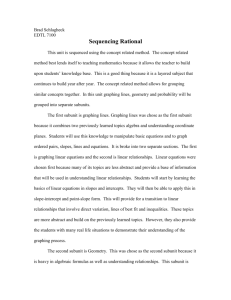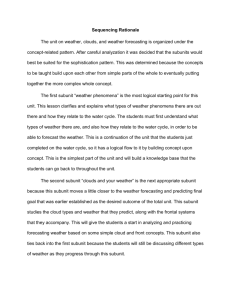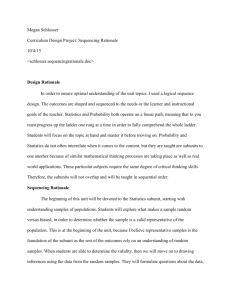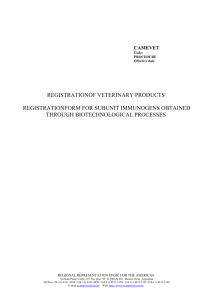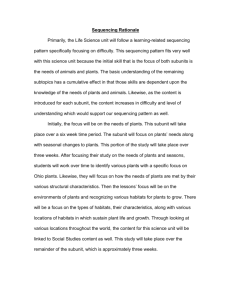ggge2055-sup-0002-txts01
advertisement
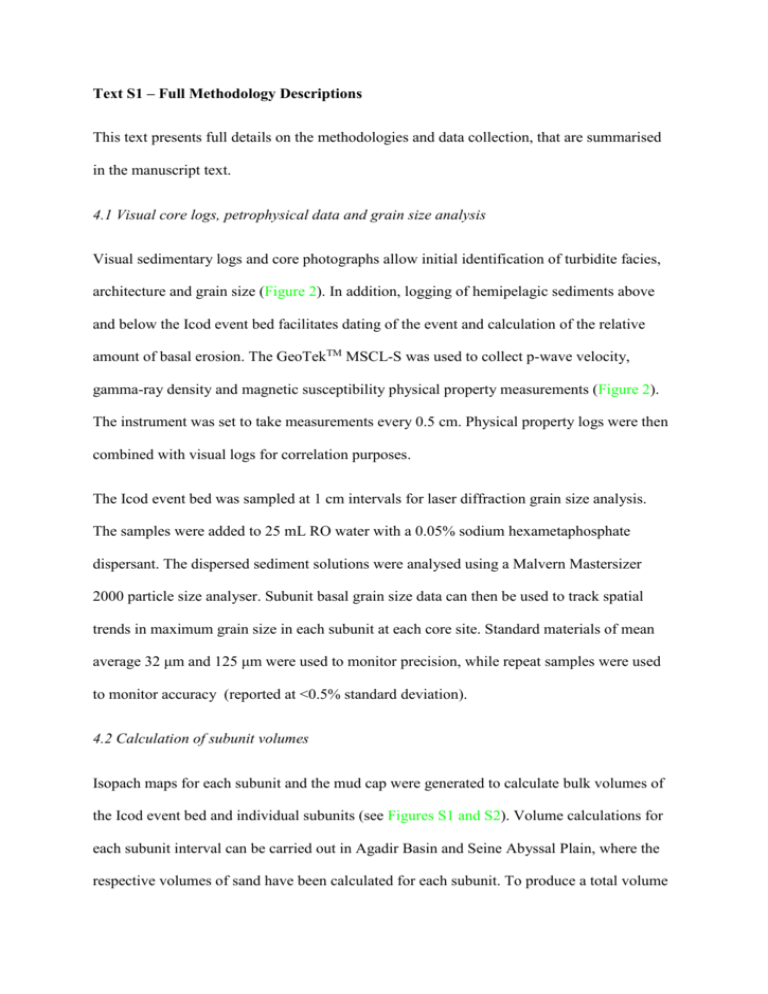
Text S1 – Full Methodology Descriptions This text presents full details on the methodologies and data collection, that are summarised in the manuscript text. 4.1 Visual core logs, petrophysical data and grain size analysis Visual sedimentary logs and core photographs allow initial identification of turbidite facies, architecture and grain size (Figure 2). In addition, logging of hemipelagic sediments above and below the Icod event bed facilitates dating of the event and calculation of the relative amount of basal erosion. The GeoTekTM MSCL-S was used to collect p-wave velocity, gamma-ray density and magnetic susceptibility physical property measurements (Figure 2). The instrument was set to take measurements every 0.5 cm. Physical property logs were then combined with visual logs for correlation purposes. The Icod event bed was sampled at 1 cm intervals for laser diffraction grain size analysis. The samples were added to 25 mL RO water with a 0.05% sodium hexametaphosphate dispersant. The dispersed sediment solutions were analysed using a Malvern Mastersizer 2000 particle size analyser. Subunit basal grain size data can then be used to track spatial trends in maximum grain size in each subunit at each core site. Standard materials of mean average 32 μm and 125 μm were used to monitor precision, while repeat samples were used to monitor accuracy (reported at <0.5% standard deviation). 4.2 Calculation of subunit volumes Isopach maps for each subunit and the mud cap were generated to calculate bulk volumes of the Icod event bed and individual subunits (see Figures S1 and S2). Volume calculations for each subunit interval can be carried out in Agadir Basin and Seine Abyssal Plain, where the respective volumes of sand have been calculated for each subunit. To produce a total volume for each subunit, the mud component has to be calculated. Each subunit has a limited individual mud cap and the whole deposit is also topped by a thick mud cap, associated with amalgamation of part of the suspension from all subunits (Figure 2). A ratio, based on individual subunit sand volumes, was used to attribute a mud volume to each subunit from the total mud cap. The error on the volume calculations is 10% based on numerous iterations of isopach maps with degrees of uncertainty incorporated. To calculate individual subunit volumes in the more complex Madeira Abyssal Plain, the ratios of subunit volumes in Agadir Basin were applied to the total Icod event bed volume recovered from the Madeira Abyssal Plain. 4.3 Sand fraction petrography Bulk samples were taken from all the Icod event bed subunit sand intervals within Agadir Basin and Seine Abyssal Plain. These were wet sieved using deionised water to remove the <63 μm fraction. The carbonate-free bulk sample at grain-size fractions of 63-90 μm, 90-125 μm and 125-250 μm were point counted to >300 grains for mineralogy. A grain counting chamber was used in conjunction with a binocular microscope, where cells were selected at random to remove bias. 4.4 ICP-OES bulk geochemistry Bulk samples were taken from each subunit sand interval from each available core in Agadir Basin and Seine Abyssal Plain. The >32μm fraction was separated by wet sieving, dried and weighed before the carbonate content was leached by addition of 5 mL 10% acetic acid. Then 100 μg of carbonate-free sample was powdered for acid digestion, firstly with 5 mL aqua regia (3:1 HCl:HNO3), and then with 3 mL HF and 2.25 mL perchloric acid. The final silicafree residue was dissolved in 6 M HCl, from which 0.6 M HCl daughter solutions were made for analysis (Table S1). A number of terrigenous and volcanic standard reference materials (SRMs) were used to assess precision, with sample and SRM duplicates used to assess accuracy of the methodology. The ranges of concentrations used in the standards were defined by ICP-AES elemental concentrations from previous studies of Madeira Abyssal Plain turbidites (de Lange et al., 1987). The standard reference materials demonstrated that major element analyses produced average precisions of 2.1% and average accuracies to the standard reference materials to within 2.3% (Table S1). With regards to trace elements, precision is between 2.0% and 20.8% (averaging 7.8%) with accuracies ranging to within 2.9% to 39.9% (averaging 16.4%) (Table S1). Those trace elements with accuracies beyond 15% were discounted from use. Tabulated data are presented in Table S2. 4.5 LEO1450 SEM and EDS Samples of, carbonate-free, 90-125 μm grain size material from subunit sand intervals at site JC27/02 (see Figure 1 for location) were made into carbon-coated thin sections. Site JC27/02 is the most proximal core site to Tenerife, and here the Icod event bed contains the coarsest grains available for analysis. Unaltered grains were selected for analysis from each subunit to investigate the geochemical variability of glass populations. Data was plotted using a TAS diagram (Le Bas et al., 1986). To investigate potential element mobility during alteration within the basal subunits, altered grains from subunit one (SBU1) from JC27/02 were chosen.The LEO 1450 variable pressure SEM and PGT microanalysis EDS was then used to produce both images and geochemical compositions of volcanic glass assemblages. Operating conditions were: 50 μm aperature size, beam current 80 μA and EHT target 20 kV. Samples were analysed quantitatively using internal standards and international standard reference materials (Table S3). The backscatter application gave an appreciation of grain internal density and contrasts between grains. In addition to two pre-prepared glass standards (BIR-1g and BRR-1g), a series of additional glasses were produced to encompass the desired range in K2O. This was done using 20 µg of powdered standard, melted at 1300oC without addition of a flux on an iridium strip utilising a thermocouple in an argon-filled chamber. Precision varies according to concentration, whereby low concentrations (<0.1 wt%) at or below the detection limits of the instrument have reproducibilities of >20% standard deviation. For concentrations >0.1 wt% the precision averaged 2.9%. The accuracy of the data comparing SRMs to certificate data varied, but averaged to within 5.8% (Table S3). Tabulated data are presented in Table S4. 4.6 TM1000 SEM The TM1000 tabletop SEM was used to take high resolution images of grains from each sand interval in core CD166/27 (Agadir Basin, Figure 1) and JC27/02 (Selvage Seamount, Figure 1). The advantage of this SEM is that minimal preparation is required to take images of 3D grains, unlike the LEO1450 SEM, which either requires carbon-coated thin sections or goldplated samples. 4.7 CO2 coulometry Inorganic carbon (carbonate) measurements were taken through a type core (CD166/27) at 1 cm intervals. Samples of 25 μg were oven dried (120oC) and ground, and then subjected to a potentiometric back-titration using a coulometer. The carbonate content is calculated from the CO2 volume liberated from the sample mass by a phosphoric acid-decomposition, where reproducibility was within 2%.
